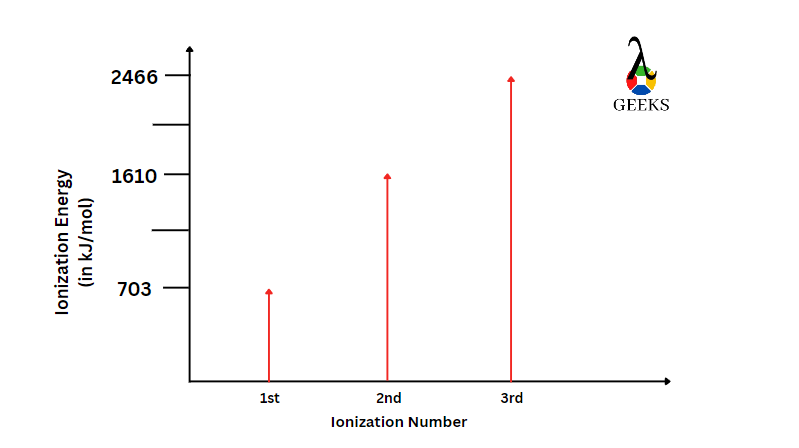Bismuth belongs to group 16 of periodic tables which are also called pnictogens. Let us read some important properties of Bismuth in the article.
Bismuth has an electronegativity of 2.02 on Pauling’s scale. Bi is a post-transition metal with atomic number 83. Bismuth electronegativity is higher than metals as it belongs to the category of non-metals. Bi oxidation states vary from -3 to +5. It is a silvery white metal with having brittle nature.
We will discuss some useful properties of Bismuth in this article, like ionization energy and electronegativity with the help of this article.
Bismuth ionization energy
Bismuth (Bi) generally shows 1st, 2nd and 3rd ionizations. The electronic configuration of Bi is [Xe] 4f14 5d10 6s2 6p3.
- The ionization energy for the 1st ionization is 703 kJ/mol. The removal of electrons will take place from the 6p orbital only.
- The ionization energy for the 2nd ionization is 1610 kJ/mol and the electron is removed from 6p orbital of Bi.
- The 3rd ionization has an ionization energy of 2466 kJ/mol. the electron is removed from the 6p orbital only.
- The first ionization energy of bismuth is high and the energies for the next ionizations increase gradually because the electronic configuration of Bi is half-filled and is highly stable.
Bismuth ionization energy graph
Bi 1st, 2nd and 3rd ionization energies are shown in the graph below.

Though the removal of the first electron is most difficult due to the half-filled stable configuration, the 2nd and 3rd ionizations are also high as the inner electrons of 6p are shielded by the other orbitals present in the Bi atom.
Bismuth and Nitrogen ionization energy
The electronic configuration energy of Bi is [Xe] 4f14 5d10 6s2 6p3 and for that of nitrogen, it is [He] 2s2 2p3. Let us see how the ionization energies of these two elements vary from each other.
| Ionization | Bi Ionization energy | N Ionization energy | Reason |
|---|---|---|---|
| 1st | 703 | 1402 | N is more electronegative than Bi; therefore, the 1st ionization energy of N is higher than Bi. |
| 2nd | 1610 | 2856 | After removing one electron, the half-filled configuration of N and Bi is disturbed; therefore, the second ionization energy has a higher value. |
| 3rd | 2466 | 4578 | N released an electron from its +2-oxidation state which is not common and that is why an immense amount of energy is required, roughly double the energy required for Bi. |
Bismuth and potassium ionization energy
The electronic configuration of Potassium is [Ar] 4s1 and the table below shows how its ionization energy differs from Bi.
| Ionization | Bi Ionization energy | K Ionization energy | Reason |
|---|---|---|---|
| 1st | 703 | 418.8 | The first ionization of P takes place from the 4s orbital with only one loosely held electron; therefore, very less ionization energy is required in comparison to Bi. |
| 2nd | 1610 | 3052 | After the P1+ state, the electronic configuration of Ar is reached which being a noble gas is highly table; therefore, very high ionization energy is required. |
| 3rd | 2466 | 4420 | After removing one electron from a stable Ar configuration, removing the successive electron becomes less difficult, but the energy required is still double that in the case of Bi. |
Bismuth and magnesium ionization energy
Magnesium electronic configuration is [Ne] 3s2. Its ionization energy for the first three ionizations are 737.7, 1450.7 and 7732.7 kJ/mol.
| Ionization | Bi Ionization energy | Mg Ionization energy | Reason |
|---|---|---|---|
| 1st | 703 | 737.7 | The removal of the first electron for Mg takes from 3s orbital and for Bi from 6p orbital which is not much difficult to remove. Therefore, the 1st ionization energy of both is almost the same. |
| 2nd | 1610 | 1450.7 | After the 2nd ionization takes place which also has almost the same ionization energy in both atoms. |
| 3rd | 2466 | 7732.7 | After the Mg2+ state, the electronic configuration of Ne is achieved and the removal of an electron from it is very hard. That is why the 3rd ionization energy of Mg is very large. |
Bismuth electronegativity
In Pauling’s scale, the electronegativity of Bi is 2.02. Bi shows higher electronegativity than metals present in the periodic table.
The reasons for the high electronegativity of Bi are:
- It belongs to the post-transition non-metals category, which is why it is an affinity to gain electrons rather than donate.
- The electronic configuration of Bi is half-filled and stable, which is why it does not easily lose its electrons.
- The size of Bi is small and the electrons are closely held by the nucleus and cannot be removed easily.
Conclusion:
This article concludes that Bismuth is an element that has high electronegativity and unordinary ionization energy. Its ionization energy is high but still lower than the neighbour non-metal atoms. The electrons here are held together by the nuclear force.
Read more about Energy & Electronegativity:
| obalt Ionization Beryllium Ionization |
Calcium Ionization Bromine |
Bismuth Ionization | Arsenic | Chromium Ionization |

Hi, I am Sahil Singh. I completed my graduation in Bachelor of Science. I always have keen interest in Physics & Chemistry. I worked on my own blog for 1 year in the technology and gaming niche. I try my best to provide valuable knowledge through my articles.
You can reach out to me on LinkedIn: